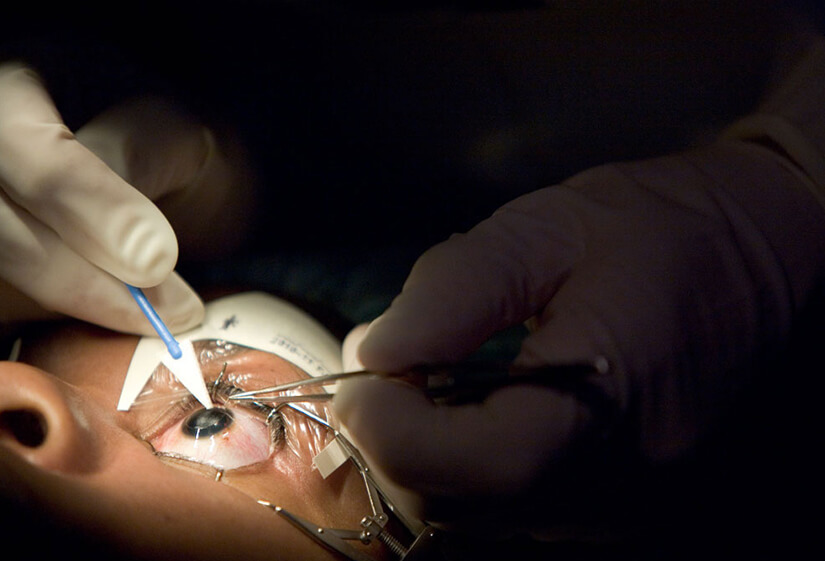Introduction
As technology in eye care continues to advance, surgical procedures like Implantable Collamer Lens (ICL) surgery have become increasingly popular as a solution for those seeking vision correction. While ICL offers numerous benefits, such as better visual outcomes for patients with high prescriptions or thin corneas, it is important to understand the potential risks associated with the surgery. Before deciding whether ICL is the right choice, patients must be fully aware of what the procedure entails, the risks involved, and how they can manage these risks. This article explores the ins and outs of ICL surgery, including its workings, potential risks, and how you can minimize them.
What is ICL (Implantable Collamer Lens)?
An Implantable Collamer Lens (ICL) is a type of vision correction surgery where a synthetic lens made of Collamer (a biocompatible material) is implanted into the eye to improve vision. Unlike LASIK, which reshapes the cornea, ICL surgery involves inserting a lens between the cornea and the iris to correct refractive errors, such as nearsightedness (myopia), farsightedness (hyperopia), and astigmatism.
Why Do People Choose ICL Over LASIK?
ICL surgery offers several advantages over LASIK for certain patients:
- Higher Prescription Levels: ICL is ideal for patients with severe nearsightedness or farsightedness that may not be treatable with LASIK.
- Thin Corneas: Some patients have corneas too thin to undergo LASIK safely. ICL doesn’t rely on reshaping the cornea, making it an alternative for these patients.
- Better Results in Some Cases: Many patients experience clearer vision post-ICL, especially those with high refractive errors.
- Reversibility: Unlike LASIK, the ICL lens can be removed or replaced if necessary, providing an added safety net for patients.
Importance of Understanding Potential Risks
Every surgery, including ICL, carries potential risks. While the procedure generally has a high success rate, it’s important to be aware of possible complications. Understanding the risks can help patients make informed decisions, minimize complications, and ensure they achieve the best results possible.

How ICL Works
The Procedure Explained
ICL surgery is typically performed under local anesthesia, meaning the patient remains awake during the procedure. The surgeon makes a small incision at the edge of the cornea, through which the lens is inserted and positioned between the cornea and the iris. Once the lens is in place, the incision heals naturally without the need for stitches.
Who is an Ideal Candidate?
ICL is best suited for individuals who meet certain criteria:
- Age: Usually between 21 and 45 years, as the eye’s refractive error should have stabilized.
- Stable Vision: Candidates must have had a stable prescription for at least one year.
- Adequate Eye Health: Healthy eyes free of significant conditions such as glaucoma, cataracts, or severe dry eye.
- High Prescription: Ideal for those with high myopia or hyperopia who are not eligible for LASIK.
Recovery and Expected Results
Recovery from ICL surgery is relatively quick. Most patients experience improved vision within 24 hours, with a few weeks required for full stabilization. A follow-up visit is necessary to ensure the lens is positioned correctly and no complications arise. Most patients can return to regular activities within a few days, though they must avoid strenuous activities for a short period.
Common Risks Associated with ICL Surgery
While ICL surgery is generally safe, like any surgery, it carries potential risks and complications. Below are some of the most common risks associated with the procedure:
Increased Intraocular Pressure (IOP)
How ICL Can Lead to Glaucoma
One of the most common complications after ICL surgery is an increase in intraocular pressure (IOP), which can lead to glaucoma. The ICL lens can sometimes obstruct the natural outflow of fluid in the eye, causing the pressure to rise. If left untreated, this increased pressure can damage the optic nerve and result in glaucoma.
Symptoms and Management
Patients should be aware of the symptoms of elevated intraocular pressure, which include eye pain, blurred vision, and headaches. Regular post-operative eye exams can help monitor IOP, and medications or further surgical intervention can be used to manage this risk.
Cataract Development
How ICL Can Increase the Risk of Cataracts
Another potential risk is the development of cataracts. Over time, the ICL lens can cause changes to the eye’s natural lens, increasing the likelihood of cataract formation, particularly in older patients.
Treatment Options if a Cataract Develops
If a cataract does develop after ICL surgery, it can usually be treated with traditional cataract surgery, which involves removing the cloudy natural lens and replacing it with an artificial one.
Night Vision Issues
Glare and Halos
One of the more common complaints after ICL surgery is visual disturbances such as glare and halos, particularly at night. Patients may experience difficulty driving at night or feel discomfort from bright lights.
How to Manage Post-Surgery Visual Disturbances
These symptoms often subside within a few months after surgery, but in some cases, they may persist. Patients can manage these symptoms by avoiding bright light or using corrective lenses designed to reduce glare.
Endothelial Cell Loss
Understanding Its Impact on Corneal Health
The corneal endothelium is a layer of cells responsible for keeping the cornea clear. In some cases, the insertion of the ICL lens can lead to a loss of endothelial cells, which can cause the cornea to become cloudy over time.
Preventive Measures and Regular Monitoring
To minimize the risk of endothelial cell loss, regular monitoring by an eye care professional is essential. In severe cases, further treatment or a lens replacement may be necessary.
Infection and Inflammation
Rare But Possible Complications
Infections and inflammation inside the eye, while rare, can occur after any surgery, including ICL. These conditions can lead to severe complications if not addressed promptly.
Prevention and Treatment
Antibiotic eye drops are typically prescribed following the surgery to reduce the risk of infection. Any signs of infection, such as redness, discharge, or increased pain, should be reported to an eye doctor immediately.
Lens Malpositioning or Rotation
What Happens if the ICL Shifts?
While uncommon, the ICL lens can sometimes shift out of position, affecting visual acuity. If the lens moves, it may cause discomfort or blurry vision.
Surgical Correction Options
If lens malposition occurs, further surgical intervention may be required to reposition or replace the lens.
Rare but Serious Complications
While the risks mentioned above are relatively common, there are a few rare but serious complications that patients should be aware of.
Retinal Detachment
Who is at Higher Risk?
Retinal detachment is a rare but potentially serious complication that can occur after ICL surgery. Those with a high degree of myopia are at greater risk due to the increased length of the eye, which can make the retina more susceptible to detachment.

Signs and Immediate Actions
Symptoms of retinal detachment include sudden flashes of light, a shadow or curtain effect in the vision, and a sudden increase in floaters. Immediate medical attention is required if these symptoms occur.
Over or Under Correction
When Vision Correction Isn’t Perfect
In some cases, ICL surgery may lead to overcorrection (where the vision becomes too sharp) or undercorrection (where the vision doesn’t improve enough). This may happen if the lens does not fully correct the refractive error.
Possible Solutions Including Enhancements
If the vision is not perfectly corrected, enhancement surgery can be performed to adjust the lens or correct the refractive error further.
Vision Fluctuations
What Causes Instability in Vision Post-ICL?
Some patients may experience fluctuations in their vision, especially in the early stages after surgery. This can be caused by the healing process or minor issues with the lens.
When to Consult Your Doctor
If vision fluctuations persist for several weeks, it’s important to consult with your surgeon to rule out any underlying issues.
Minimizing Risks Before and After Surgery
Choosing a Skilled Surgeon
The success of ICL surgery largely depends on the skill of the surgeon. An experienced ophthalmologist who specializes in ICL surgery will reduce the risk of complications.
What to Ask Before Undergoing Surgery
Before proceeding with ICL surgery, ask the surgeon about their experience, success rates, and potential risks. Make sure to discuss any concerns you may have regarding the procedure.
Post-Operative Care Tips
To ensure a smooth recovery, follow the post-operative instructions carefully. This includes using prescribed eye drops, attending follow-up appointments, and avoiding activities that could stress the eye.
Regular Follow-Ups and Monitoring
Regular follow-up visits are essential to monitor healing progress and address any complications early.
Lifestyle Adjustments for Eye Health
Maintaining a healthy diet, regular exercise, and proper eye care habits are crucial for long-term eye health. Protect your eyes from UV exposure and avoid smoking to reduce the risk of complications.

ICL Surgery Costs in India and Bangalore
| City | Price Range (INR) |
|---|---|
| India (General) | ₹60,000 – ₹1,50,000 |
| Bangalore | ₹70,000 – ₹1,80,000 |
The cost of ICL surgery varies depending on the clinic, the complexity of the procedure, and the surgeon’s expertise.
Conclusion
ICL surgery can provide a life-changing improvement in vision, especially for those who are not candidates for LASIK. However, it is important to carefully weigh the benefits against the risks. By understanding the potential complications and working closely with an experienced surgeon, patients can make an informed decision and achieve the best possible outcomes.
FAQs
Is ICL Safer Than LASIK?
ICL is generally safe for patients who are not candidates for LASIK, but the risks of each procedure depend on individual factors.
How Long Do ICLs Last?
ICLs are designed to last a lifetime, although they may need to be replaced in rare cases.
Can ICL Cause Permanent Blindness?
Permanent blindness is extremely rare. Most complications can be managed with proper treatment.
What Should I Do If I Experience Discomfort After ICL Surgery?
If you experience significant discomfort, consult your surgeon immediately to rule out any complications.
How Can I Know if I Am a Good Candidate for ICL?
Consult an experienced ophthalmologist who will assess your eye health and refractive error to determine if ICL is a suitable option.











